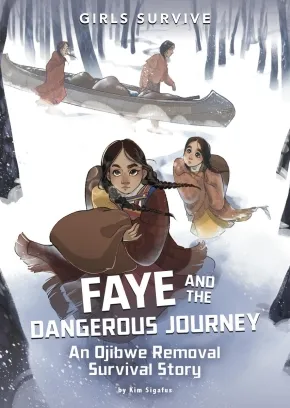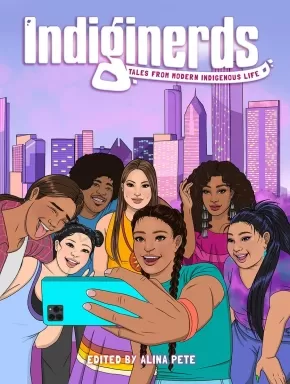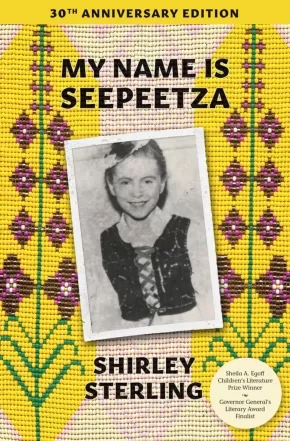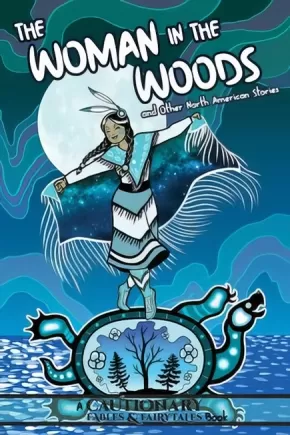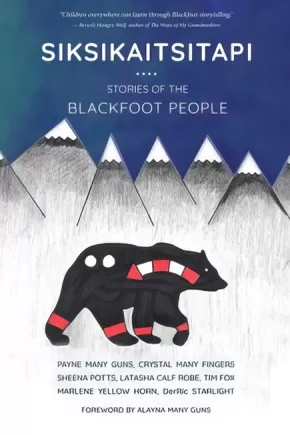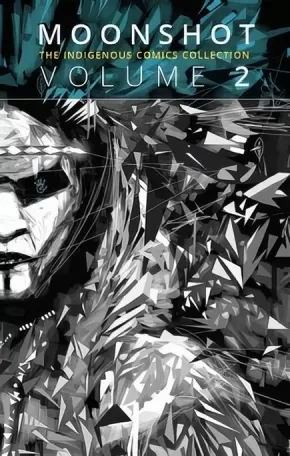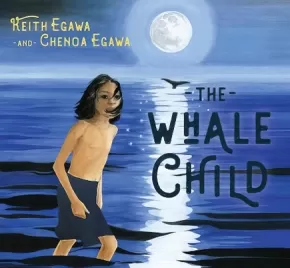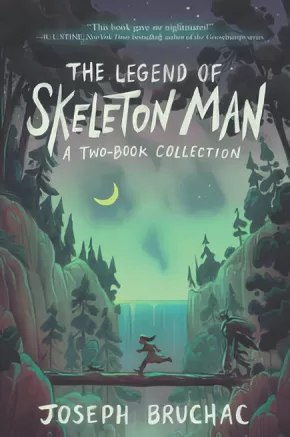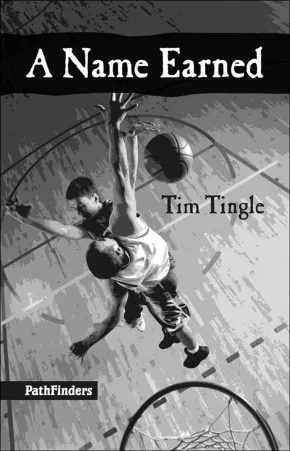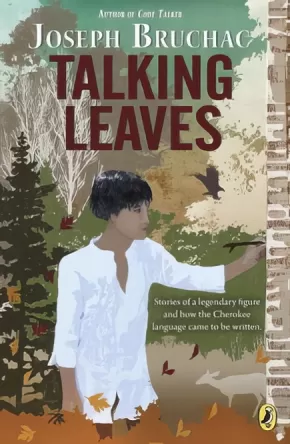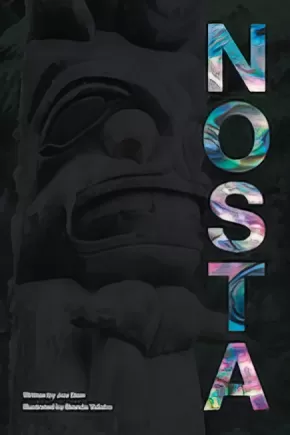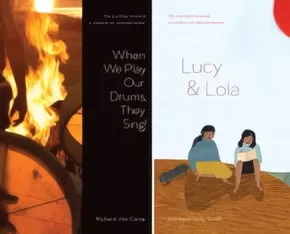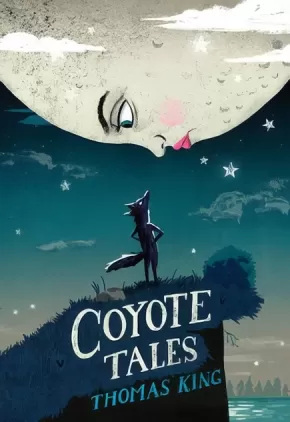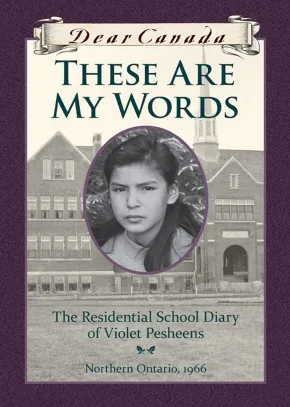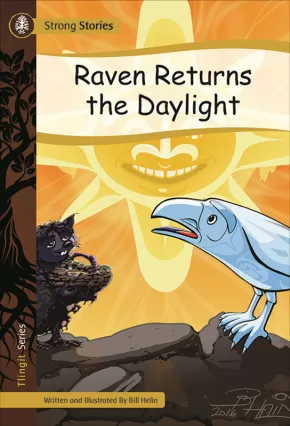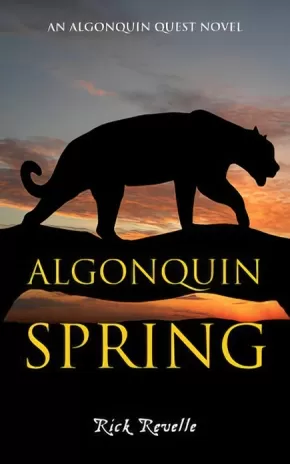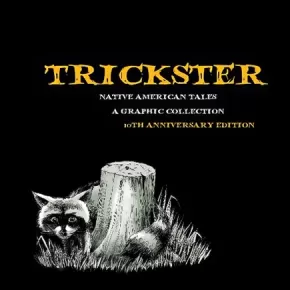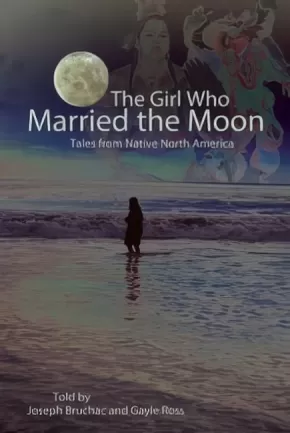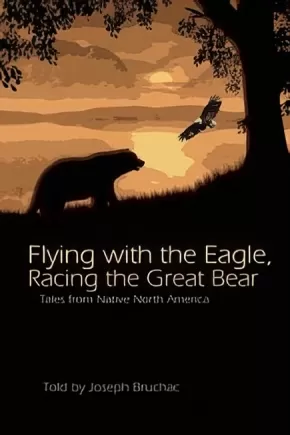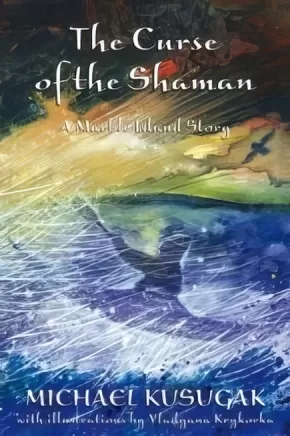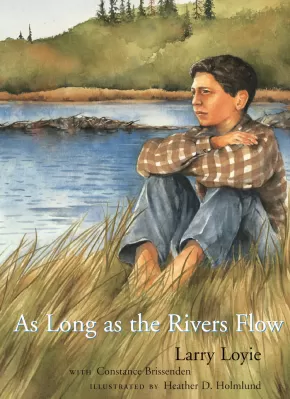
Indigenous Stories / Narratives
1
-
15
of
34 Results;
Sort By
Go To
of 3
Faye and the Dangerous Journey: An Ojibwe Removal Survival Story
$13.99
Artists:
Format:
Paperback
Text Content Territories:
Indigenous American; Native American; Anishinaabeg; Ojibwe (Chippewa);
ISBN / Barcode: 9781669086239
Synopsis:
Synopsis:
In the fall of 1850, Faye and her family begin a long, difficult journey with thousands of other Ojibwe people to receive money the U.S. government owes them. But why isn’t the money being delivered to them in Wisconsin, as usual? Why must they walk and canoe all the way to the middle of Minnesota in terrible weather? These are questions Faye asks, but the answers don’t make sense. When her family reaches their destination, Mama is sick, and there is no money as promised. Will Faye and her family make it back home? Will there be a home to return to? In this gripping story with nonfiction backmatter—including an author’s note, discussion questions, and more—readers will learn about the traumatic events of the Sandy Lake Ojibwe removal in this Girls Survive historical fiction.
Educator Information
Recommended for ages 8 to 12.
Additional Information
112 pages | 5.25" x 7.50" | Paperback
Ullak and the Creatures of the Sea
$14.95
Artists:
Format:
Paperback
Text Content Territories:
Indigenous Canadian; Inuit;
ISBN / Barcode: 9781774505762
Synopsis:
Synopsis:
One day, Ullak forgets her grandma's warning about playing on the ice pans and is suddenly kidnapped by a sea monster.
Ullak is brought to Sanna, the ruler of the seas and all the mammals in it, at the bottom of the sea. Together they visit different Arctic sea animals and learn all about them. Ullak is having a lot of fun exploring underwater, but it's getting late. Will she be able to convince Sanna to help her find her way home?
Educator Information
Recommended for ages 8 to 10.
F&P Level: R
Ullak and the Creatures of the Sea features Sanna, a prominent figure in Inuit traditional stories.
Additional Information
48 pages | 6.00" x 9.00" | Paperback
Indiginerds: Tales from Modern Indigenous Life
$30.95
Artists:
Format:
Paperback
Text Content Territories:
Indigenous Canadian;
ISBN / Barcode: 9781638991335
Synopsis:
Synopsis:
First Nations culture is living, vibrant, and evolving, and generations of Indigenous kids have grown up with pop culture creeping inexorably into our lives. From gaming to social media, pirate radio to garage bands, Star Trek to D&D, and missed connections at the pow wow, Indigenous culture is so much more than how it’s usually portrayed. Indiginerds is here to celebrate those stories!
Featuring an all-Indigenous creative team, Indiginerds is an exhilarating anthology collecting 11 stories about Indigenous people balancing traditional ways of knowing with modern pop culture. Includes work by Alina Pete, PJ Underwood, Kameron White, Rhael McGregory, and many more.
Educator Information
Recommended for ages 12 to 18.
Full Creator Listing: Tate Allen, Ida Aronson, Jordanna George, Raven John, Nipinet Landsem, Rhael McGregor, Sam “Mushki” Medlock, Alina Pete, Wren Rios, PJ Underwood, Kameron White
Additional Information
120 pages | 6.62" x 10.25" | Paperback
Suliewey: The Sequel to My Indian
$16.95
Format:
Paperback
Text Content Territories:
Indigenous Canadian; First Nations; Beothuk; Mi'kmaq;
ISBN / Barcode: 9781550819885
Synopsis:
Synopsis:
Suliewey: The Sequel to My Indian continues the story of Mi’kmaw guide Sylvester Joe, whose traditional name is Suliewey, as he seeks out the last remaining Beothuk community.
In My Indian, Sylvester was hired by William Cormack in 1822 to guide him across Newfoundland in search of Beothuk encampments. In fact, he followed the advice of his Elders and guided Cormack away from the Beothuk.
In this sequel, having parted ways with Cormack at St. George’s Bay, Sylvester decides to go out on his own, in search of the winter camp of the last of the remaining Beothuk.
Written as fiction, by two Mi’kmaq authors, Suliewey: The Sequel to My Indian supports Mi’kmaq oral history of friendly relationships with the Beothuk.
The novel reclaims the settler narrative that the Beothuk and the Mi’kmaq of Newfoundland were enemies and represents an existing kinship between the Mi’kmaq and the Beothuk.
Rich in oral history, the descriptions of traditional ceremonies and sacred medicines, the use of Mi’kmaw language, and the teachings of two-spirit place readers on the land and embed them in the strong relationships described throughout the book.
Educator & Series Information
Recommended for ages 12 to 14.
This is the second book in the My Indian series.
Additional Information
232 pages | 5.25" x 8.00" | b&w illustrations | Paperback
232 pages | 5.25" x 8.00" | b&w illustrations | Paperback
Eagle Drums
$24.99
Format:
Hardcover
Text Content Territories:
Indigenous American; Alaska Native; Inupiat;
ISBN / Barcode: 9781250750655
Synopsis:
Synopsis:
A magical realistic middle-grade debut about the origin story of the Iñupiaq Messenger Feast, a Native Alaskan tradition.
As his family prepares for winter, a young, skilled hunter must travel up the mountain to collect obsidian for knapping—the same mountain where his two older brothers died.
When he reaches the mountaintop, he is immediately confronted by a terrifying eagle god named Savik. Savik gives the boy a choice: follow me or die like your brothers.
What comes next is a harrowing journey to the home of the eagle gods and unexpected lessons on the natural world, the past that shapes us, and the community that binds us.
Eagle Drums by Nasuġraq Rainey Hopson is part cultural folklore, part origin myth about the Messenger’s Feast – which is still celebrated in times of bounty among the Iñupiaq. It’s the story of how Iñupiaq people were given the gift of music, song, dance, community, and everlasting tradition.
Awards
- 2024 Newbery Honor Book
- 2024 American Indian Library Association Youth Literature Award
Reviews
“A soaring story of family and courage, culture and community, wonder and resilience.” — Cynthia Leitich Smith, anthologist of Ancestor Approved: Intertribal Stories for Kids
“An epic journey in every sense of the word, Eagle Drums is a new classic. Pinja welcomes the reader to travel with him on this treacherous quest and by the time his voyage is complete, you will grieve, struggle, and celebrate alongside him.” —Donna Barba Higuera, author of Newbery Medal winner The Last Cuentista
“Nasuġraq Rainey Hopson has accomplished something truly monumental. Through her impressive talents as a writer and artist, Rainey shares cultural teachings and, indeed, the art of storytelling with readers of all ages. Eagle Drums is a masterpiece!” —Angeline Boulley, author of the #1 New York Times bestseller Firekeeper's Daughter
Educator Information
Recommended for ages 8 to 12.
Additional Information
256 pages | 5.38" x 8.25" | Hardcover
Andy's Tribal Canoe Journey
 $21.95
$21.95

Artists:
Format:
Paperback
ISBN / Barcode: 9781771746007
Synopsis:
Synopsis:
Andy has had a rough school year and is ready for summer vacation. But when Grandpa Rick tells him that he will be participating in a canoe journey instead of enjoying his usual summer activities, Andy feels he is being punished.
Join Andy as he experiences a Tribal Canoe Journey for the first time and learns what it’s like to belong to a canoe family. Follow along as Andy navigates physical and emotional challenges and finds an answer to the important question: “Who am I?”
Awards
- 2024-2025 Hackmatack Children's Choice Award Shortlisted
Reviews
“Andy's Tribal Canoe Journey is a fantastic book to use for reading groups. We were able to have amazing discussions.… Students loved the pictures and the story. I hope to read this with as many students as possible.” – Holly Polischuk, Cayoosh Elementary School educator
"This graphic novel highlights how First Peoples connect to their culture and honour their past. The first-hand perspectives of participants in the 2019 journey help showcase the human emotions and physical challenges it involves. Teachers across elementary and secondary levels can use this short graphic novel as a read-aloud in a classroom or literature circles to help students learn about Tribal Canoe Journeys. Students could also be invited to explore their own traditions and experiences, and the art in the book could inspire projects that are based on the illustrations in this story." – Focused Education Resources
Educator Information
Recommended for grades 3 to 8.
Additional Information
72 Pages | 8" x 10" | Paperback | ISBN: 978-1-77174-600-7
My Name is Seepeetza: 30th Anniversary Edition
$12.99
Format:
Paperback
Text Content Territories:
Indigenous Canadian; First Nations; Salish; Interior Salish; Nlaka'pamux (Thompson);
ISBN / Barcode: 9781773068565
Synopsis:
Synopsis:
An honest look at life in an Indian residential school in the 1950s, and how one indomitable young spirit survived it — 30th anniversary edition.
Seepeetza loves living on Joyaska Ranch with her family. But when she is six years old, she is driven to the town of Kalamak, in the interior of British Columbia. Seepeetza will spend the next several years of her life at an Indian residential school. The nuns call her Martha and cut her hair. Worst of all, she is forbidden to “talk Indian,” even with her sisters and cousins.
Still, Seepeetza looks for bright spots — the cookie she receives at Halloween, the dance practices. Most of all, there are her memories of holidays back at the ranch — camping trips, horseback riding, picking berries and cleaning fish with her mother, aunt and grandmother. Always, thoughts of home make school life bearable.
Based on her own experiences at the Kamloops Indian Residential School, this powerful novel by Nlaka’pamux author Shirley Sterling is a moving account of one of the most blatant expressions of racism in the history of Canada.
Includes a new afterword by acclaimed Cree author Tomson Highway of the Barren Lands First Nation in northern Manitoba.
Educator Information
Recommended for ages 9 to 12.
Key Text Features: afterword, dialogue, journal entries, maps.
Correlates to the Common Core State Standards in English Language Arts:
CCSS.ELA-LITERACY.RL.4.2
Determine a theme of a story, drama, or poem from details in the text; summarize the text.
CCSS.ELA-LITERACY.RL.5.1
Quote accurately from a text when explaining what the text says explicitly and when drawing inferences from the text.
CCSS.ELA-LITERACY.RL.6.6
Explain how an author develops the point of view of the narrator or speaker in a text.
Includes a new afterword by acclaimed Cree author Tomson Highway of the Barren Lands First Nation in northern Manitoba.
Additional Information
128 pages | 5.10" x 7.50"
The Woman in the Woods and Other North American Stories
$22.95
Artists:
Editors:
Format:
Paperback
Text Content Territories:
Indigenous Canadian; First Nations; Anishinaabeg; Odawa (Ottawa); Ojibway; Serpent River First Nation; Cree (Nehiyawak); Plains Cree; Little Pine First Nation; Métis; Indigenous;
ISBN / Barcode: 9781945820977
Synopsis:
Synopsis:
“Be careful of what you accept from spirits.”
Loup Garrou, trickster rabbits, and spirits with names that can’t be spoken — the plains and forests of North America are alive with characters like these, all waiting to meet you in this collection of folklore retold in comics!
Reviews
"Enjoyable for reading aloud or sharing around a campfire." -- KIRKUS
"Explores the stories, passed down through generations, of the people who have inhabited Turtle Island since time immemorial." - Women Write About Comics
Educator Information
Comic book recommended for ages 10 to 12.
The book features more than 100 pages of entertaining and educational stories by artists and writers from Indigenous nations across the continent, including:
- “As It Was Told to Me”, a creation tale that shows that the world needs good and bad to exist, which is written and illustrated by Elijah Forbes, a transgender Odawa illustrator who has facilitated the creation of illustration projects such as the 2020 “Trans Awareness Week.”
- “Chokfi,” the story of the trickster rabbit, who is jealous of Otter's fur coat and tries to steal it, by writer Jordaan Arledge, a trans Chickasaw comic writer and the founder of Arledge Comics, and artist Mekala Nava.
- “White Horse Plains”, a cautionary tale about greed that comes from the Métis settlement St. Francois Xavier, as told by Rhael McGregor, a Non-Binary/Two-Spirit Métis comic artist and animator from Winnipeg, Manitoba.
- “Rougarou” by Mystery Solving Lesbians writer Maija Ambrose Plamondon and Métis-based artist Milo Applejohn, about a werewolf-like creature that haunts the Métis communities.
- “Agonjin In the Water” by the non-binary Ojibawe artist Alice RL, about a girl whose tribe is suffering from a drought and finds a Mishipeshu while searching for water.
- “Woman in the Woods” by the Cuban Taíno artist and storyteller Mercedes Acosta about a curious girl who sees a mysterious figure in the woods at night.
- “Into Darkness” by Izzy Roberts, a Michigan-based illustrator and a member of the Navajo Nation and Kinyaa’áanii clan, about a creature so dangerous and scary that no one dares utter its name.
Additional Information
120 pages | 6.06" x 9.04" | Black and white throughout | Paperback
Siksikaitsitapi: Stories of the Blackfoot People
$37.50
Text Content Territories:
Indigenous Canadian; First Nations; Blackfoot Confederacy (Siksikaitsitapi); Piikani (Peigan, Aapatohsipikani); Kainai (Blood); Siksika (Blackfoot);
ISBN / Barcode: 9781988824833
Synopsis:
Synopsis:
In Siksikaitsitapi: Stories of the Blackfoot People, seven authors share their stories that come from both from legend and from their personal experiences, with many of the stories in both Blackfoot and English languages. The book is illustrated with beautiful full-colour pictures and photos which help convey these stories from Blackfoot traditional and contemporary traditions and cultures. The Blackfoot Confederacy is made up of the Siksika, Kainai, Piikani, and Amskapi Piikuni Nations of Southern Alberta and Montana.
Payne Many Guns' story captures the ways the Blackfoot People live in harmony with the land, animals, and stars in their traditional lands.
Crystal Many Fingers tells a delightful, modern story about animals, their gifts, and why they were put on Earth.
Sheena Potts' story beautifully illustrates the many ways love is alive in Blackfoot traditions and culture.
Tim Fox tells a humerous story about mice who are having a celebration that the raven Napi and a group of dogs want to join.
Marlene Yellow Horn shares her personal story of the teachings she learned as a child about the Elders' traditional and sacred knowledge.
DerRic Starlight tells the tale of Morning Star's diverse and loving family life.
Foreword is by Alayna Many Guns.
Educator & Series Information
The publisher recommends this title for grades 6 to 12, but these stories will appeal to children of all ages.
This book is part of the Indigenous Spirit of Nature series.
"These Blackfoot children’s book chapters share common knowledge stories which have been shared to our authors. Common knowledge includes everyday lessons and norms. The book provides us with an opportunity to reclaim our truths. In the past, sitting with an Elder and listening to traditional stories of the stars, the animals, Napi, and our purpose was a great gift. Today, this is more important than ever. Elders gift us with purpose, strength, knowledge, and love." - Alayna Many Guns, from the foreword
Additional Information
144 pages | 6.00" x 9.00" | Colour illustrations | Paperback
Putuguq & Kublu and the Attack of the Amautalik
$9.95
Artists:
Format:
Paperback
Text Content Territories:
Indigenous Canadian; Inuit;
ISBN / Barcode: 9781772274196
Synopsis:
Synopsis:
In each new adventure, Putuguq and Kublu learn about an element of Inuit mythology from their Elders, sometimes using what they learn to get the best of each other!
Putuguq and Kublu are at their grandparents’ house for lunch—caribou stew, Putuguq’s favourite! Putuguq’s worn out (and stinky!) kamiik remind his grandparents of the story of the amautalik and the orphan, a traditional Inuit story about a little orphan who outsmarts a child-stealing ogress. Grandmother’s storytelling over lunch starts Putuguq’s imagination running wild . . .
After lunch, Putuguq and Kublu decide to play a game of hide-and-seek. But, for Putuguq, this is no ordinary game. The house is full of strange noises, and what is that hulking figure? Could an amautalik really be stalking him inside his grandparents’ house? Putuguq is about to find out!
Educator & Series Information
Recommended for ages 6 to 8.
This book is part of the Putuguq & Kublu series.
Additional Information
40 pages | 6.00" x 8.00" | Paperback
Aggie and Mudgy: The Journey of Two Kaska Dena Children
$14.95
Format:
Paperback
Text Content Territories:
Indigenous Canadian; First Nations; Dene; Kaska Dena (Denek’eh);
ISBN / Barcode: 9781772033755
Synopsis:
Synopsis:
Based on the true story of the author’s biological mother and aunt, this middle-grade novel traces the long and frightening journey of two Kaska Dena sisters as they are taken from their home to attend residential school.
When Maddy discovers an old photograph of two little girls in her grandmother’s belongings, she wants to know who they are. Nan reluctantly agrees to tell her the story, though she is unsure if Maddy is ready to hear it. The girls in the photo, Aggie and Mudgy, are two Kaska Dena sisters who lived many years ago in a remote village on the BC–Yukon border. Like countless Indigenous children, they were taken from their families at a young age to attend residential school, where they endured years of isolation and abuse.
As Nan tells the story, Maddy asks many questions about Aggie and Mudgy’s 1,600-kilometre journey by riverboat, mail truck, paddlewheeler, steamship, and train, from their home to Lejac Residential School in central BC. Nan patiently explains historical facts and geographical places of the story, helping Maddy understand Aggie and Mudgy’s transitional world. Unlike many books on this subject, this story focuses on the journey to residential school rather than the experience of attending the school itself. It offers a glimpse into the act of being physically uprooted and transported far away from loved ones. Aggie and Mudgy captures the breakdown of family by the forces of colonialism, but also celebrates the survival and perseverance of the descendants of residential school survivors to reestablish the bonds of family.
Awards
- City of Victoria Children’s Book Prize 2022
Educator Information
Middle-grade novel recommended for ages 9 to 12.
Additional Information
144 pages | 5.50" x 8.00" | Paperback
Moonshot: The Indigenous Comics Collection Volume 3
$23.95
Artists:
Editors:
Format:
Paperback
Text Content Territories:
Indigenous Canadian;
ISBN / Barcode: 9780228706229
Synopsis:
Synopsis:
MOONSHOT: The Indigenous Comics Collection brings together dozens of creators from North America to contribute comic book stories showcasing the rich heritage and identity of indigenous storytelling. From traditional stories to exciting new visions of the future, this collection presents some of the finest comic book and graphic novel work on the continent.
Educator & Series Information
Inhabit Education Books is proud to distribute this important collection of Indigenous comic stories, originally published by Alternate History Comics. Moonshot has been published under Avani, an imprint featuring titles that extend beyond the Canadian North, giving readers the opportunity to explore cultures and stories from all over Canada and around the world.
Ages 12+
This is volume 3 in the series.
Additional Information
144 pages | 6.50" x 10.25" | colour illustrations
Moonshot: The Indigenous Comics Collection Volume 2
$19.95
Artists:
Editors:
Format:
Paperback
Text Content Territories:
Indigenous Canadian;
ISBN / Barcode: 9780228706212
Synopsis:
Synopsis:
MOONSHOT: The Indigenous Comics Collection brings together dozens of creators from North America to contribute comic book stories showcasing the rich heritage and identity of indigenous storytelling. From traditional stories to exciting new visions of the future, this collection presents some of the finest comic book and graphic novel work on the continent.
Educator & Series Information
Inhabit Education Books is proud to distribute this important collection of Indigenous comic stories, originally published by Alternate History Comics. Moonshot has been published under Avani, an imprint featuring titles that extend beyond the Canadian North, giving readers the opportunity to explore cultures and stories from all over Canada and around the world.
Ages 12+
This is volume 2 in the Moonshot series.
Additional Information
165 pages | 6.50" x 10.25" | colour illustrations
Moonshot: The Indigenous Comics Collection Volume 1
$22.95
Artists:
Editors:
Format:
Paperback
Text Content Territories:
Indigenous Canadian;
ISBN / Barcode: 9781774503690
Synopsis:
Synopsis:
MOONSHOT: The Indigenous Comics Collection brings together dozens of creators from North America to contribute comic book stories showcasing the rich heritage and identity of indigenous storytelling. From traditional stories to exciting new visions of the future, this collection presents some of the finest comic book and graphic novel work on the continent.
Educator & Series Information
Inhabit Education Books is proud to distribute this important collection of Indigenous comic stories, originally published by Alternate History Comics. Moonshot has been published under Avani, an imprint featuring titles that extend beyond the Canadian North, giving readers the opportunity to explore cultures and stories from all over Canada and around the world.
Ages 12+
This is volume 1 in the series.
Additional Information
176 pages | 6.50" x 10.25" | colour illustrations
My Indian
$16.95
Format:
Paperback
Text Content Territories:
Indigenous Canadian; First Nations; Beothuk; Mi'kmaq;
ISBN / Barcode: 9781550818789
Synopsis:
Synopsis:
In 1822, William Epps Cormack sought the expertise of a guide who could lead him across Newfoundland in search of the last remaining Beothuk camps on the island. In his journals, Cormack refers to his guide only as “My Indian.”
Now, almost two hundred years later, Mi’sel Joe and Sheila O’Neill reclaim the story of Sylvester Joe, the Mi’kmaq guide engaged by Cormack. In a remarkable feat of historical fiction, My Indian follows Sylvester Joe from his birth (in what is now known as Miawpukek First Nation) and early life in his community to his journey across the island with Cormack. But will Sylvester Joe lead Cormack to the Beothuk, or will he protect the Beothuk and lead his colonial explorer away?
In rewriting the narrative of Cormack’s journey from the perspective of his Mi’kmaq guide, My Indian reclaims Sylvester Joe’s identity.
Educator & Series Information
Recommended for ages 12 to 14.
Recommended for ages 12 to 14.
This is the first book in the My Indian series.
Additional Information
176 pages | 5.25" x 8.00" | b&w illustrations
176 pages | 5.25" x 8.00" | b&w illustrations
The Whale Child
$25.95
Format:
Paperback
Text Content Territories:
Indigenous American; Native American; Salish; Coast Salish;
ISBN / Barcode: 9781623174866
Synopsis:
Synopsis:
An inspiring children's book that introduces young readers to the environmental challenges facing the planet through the eyes of Coast Salish characters and authors
"You have family on land as you do in the sea. . . being a caretaker of the earth begins with taking care of the water that all life depends on."
Shiny is a whale child. One day his mother teaches him about the harm facing the world's oceans because of human carelessness. Shiny agrees to be turned into a boy by the ocean's water spirit so he can visit the land and alert people to these dangers. He meets Alex, a young Coast Salish girl who learns from Shiny that the living spirit of water exists in everything--glaciers, rivers, oceans, rain, plants, and all living creatures. Together the two travel the earth, confronting the realities of a planet threatened by an uncertain future. Inspired by Shiny's hope, humor, and wisdom, Alex makes the promise to become a teacher for future generations. She realizes that the timeless Indigenous value of environmental stewardship is needed now more than ever and that we must all stand up on behalf of Mother Earth.
Written and illustrated by Indigenous authors Keith Egawa and Chenoa Egawa, The Whale Child introduces children ages 7 to 12 to existing environmental issues with a message of hope, education, sharing, and action. Also included are resources for students and teachers to facilitate learning about Pacific Northwest Indigenous cultures and the environment.
Reviews
"Vivid illustrations juxtapose the beauty and scale of the natural world that the children explore. . . . This necessary read decolonizes the Western construction of climate change." —Kirkus Reviews (starred review)
"The sacred art of Indigenous storytelling is beautifully upheld in The Whale Child. It teaches us of our relationship with the living Earth, about balance and respect and the responsibilities that we hold toward one another across species. The story guides the reader using traditional Coast Salish lore in a contemporary narrative, masterfully weaving the timeless wisdom of Indigenous ways of knowing into our current reality. The whale child's journey is taken for us all. We must bear witness.” —Sherri Mitchell Weh’na Ha’mu Kwasset, author of Sacred Instructions
“Those of us with hands and feet (alas) who self-identify as members of the Earth’s Whale Tribe now have a new wonderful, strong, kind, and happy tale to represent us, and with which to remember our connection to All Things by. The Whale Child provides that ‘smart step in the right direction’ we all need.”—Paul Owen Lewis, author and illustrator of Storm Boy and Frog Girl
“The Whale Child is an environmental fable for our time. This is the story of Alex, daughter of a mixed Coast Salish and Polynesian family and Shiny, a whale turned briefly human to impart the wisdom of the ocean to humanity. The book is at turns educational, poignant, warm, sad, and funny. Chenoa and Keith Egawa’s delicate watercolor illustrations evoke the chill water, crisp air, and glowing sunshine of the beautiful Salish Sea. . . . The Whale Child is an important book for children, parents, and teachers to read and ponder.” —Bryn Barnard, author of The New Ocean
“A long time ago, we didn’t have to be taught that everything has a spirit, a life force, a memory, a moment that all things came into existence. . . . Brother and sister Keith and Chenoa Egawa bring us back to those teachings in their story The Whale Child. . . . We learn how to quiet our minds to hear the message that mother earth holds the cure, the answers, and the way to heal her if we just take a moment to reconnect and hear what she has to say.”—Janine Gibbons, Haida artist and children's book illustrator for Baby Raven Reads series, Sealaska Heritage Institute
“For the Coast Salish people, the nonhuman living world is not filled with resources to be abused and extracted—rather, these are our relatives that carry our original instructions. . . . Promoting these concepts and the necessary fusion of Indigenous ecological perspectives with western understandings is the fully realized mantra narrated for us in this marvelous story. The critical insights of our responsibilities and the truth of reciprocity—particularly with water, the first medicine—are woven into each page. Through playful adventure, the essence of ancient instructions emerges in the context of a modern world.”—Valerie Segrest, Muckleshoot, author, Native food systems strategist and wild medicine expert
Educator Information
Recommended for ages 7 to 10.
Includes colour illustrations. Beginner's chapter book.
"The story is followed by extensive backmatter: a glossary of environmental terms, a brief history of the Pacific Northwest Native cultures, classroom learning activities, and ideas for student projects. Infusing qualities of traditional storytelling into the narrative, Keith Egawa (Lummi) and Chenoa Egawa (Lummi and S’Klallam) offer a perspective on climate change from the lens of Indigenous people. By relating the tale through the eyes of children, the author-illustrator team evokes an empathy that should stir a wide audience." - Kirkus Reviews
Additional Information
136 pages | 7.00" x 6.49"
Fatty Legs: A True Story (10th Anniversary Edition) (PB)
$15.95
Artists:
Format:
Paperback
Text Content Territories:
Indigenous Canadian; Inuit; Inuvialuit (Mackenzie Inuit);
ISBN / Barcode: 9781773213507
Synopsis:
Synopsis:
The beloved story of an Inuvialuit girl standing up to the bullies of residential school, updated for a new generation of readers.
Margaret Olemaun Pokiak-Fenton’s powerful story of residential school in the far North has been reissued to commemorate the memoir’s 10th anniversary with updates to the text, reflections on the book’s impact, and a bonus chapter from the acclaimed follow-up, A Stranger at Home. New content includes a foreword from Dr. Debbie Reese, noted Indigenous scholar and founder of American Indians in Children’s Literature, while Christy Jordan-Fenton, mother of Margaret’s grandchildren and a key player in helping Margaret share her stories, discusses the impact of the book in a new preface.
With important updates since it first hit the shelves a decade ago, this new edition of Fatty Legs will continue to resonate with readers young and old.
Reviews
"I highly recommend this book for the discussion it would stir with students...Makes the harrowing residential school stories accessible to youth." — Resource Links
"Presents a unique and enlightening glimpse into the residential school experience and, most importantly, one little girl's triumph over her oppressors." — Quill & Quire
"Fatty Legs is a memoir written to introduce children to the reality of the residential school system and the focus on assimilating Indigenous peoples. The story documents the journey of a young girl who wanted to go to school to learn to read and her realization that school wasn’t what she imagined it to be." — The Dalai Lama Center
Educator Information
Themes: biography; Inuit; Indigenous peoples; Indigenous; arctic; school; self-esteem; abuse; community; prejudice; Canadian content; courage/bravery; right vs. wrong; role reversal; secrets; society; history; bullying; memoir; character education.
This resource is also available in French: Les bas du pensionnat
This resource is also available in its original format: Fatty Legs: A True Story
Additional Information
| 156 pages | 6.50" x 9.00" |
Authenticity Note
This illustrator of this book is not Indigenous; therefore, her artwork is not considered to be Authentic Indigenous Artwork according to Strong Nations Authenticity Guidelines. The archival photos from Margaret Pokiak-Fenton's personal collection, however, are considered to be authentic, which is why the book is labelled as containing Authentic Indigenous Artwork. It is up to readers to determine whether or not the images in this work are authentic for their purposes.
The Ghost Collector
$11.95
Format:
Paperback
Text Content Territories:
Indigenous Canadian; First Nations; Cree (Nehiyawak);
ISBN / Barcode: 9781773212951
Synopsis:
Synopsis:
Ghosts aren’t meant to stick around forever…
Shelly and her grandmother catch ghosts. In their hair.
Just like all the women in their family, they can see souls who haven’t transitioned yet; it’s their job to help the ghosts along their journey. When Shelly’s mom dies suddenly, Shelly’s relationship to ghosts—and death—changes. Instead of helping spirits move on, Shelly starts hoarding them. But no matter how many ghost cats, dogs, or people she hides in her room, Shelly can’t ignore the one ghost that’s missing. Why hasn’t her mom’s ghost come home yet?
Rooted in a Cree worldview and inspired by stories about the author’s great-grandmother’s life, The Ghost Collector delves into questions of grief and loss, and introduces an exciting new voice in tween fiction that will appeal to fans of Kate DiCamillo’s Louisiana’s Way Home and Patrick Ness’s A Monster Calls.
Reviews
“Allison Mills’ The Ghost Collector is both delightful and haunting. A delicious blend of the supernatural and the very real. Mills has great respect for her audience. Taking great care to keep the narrative moving while never simplifying the novel’s ideas and themes of loss. The result is a nuanced study in empathy for both the characters and the readers.” — Sunburst Award Jury, 08/20
“Simple language makes The Ghost Collector accessible to its tween audience while introducing sophisticated concepts. In Shelly, Mills has created a believable, likeable character who learns important life lessons about the future in the rich context of her cultural past.” —CM Reviews, 09/20/19
Educator Information
Recommended for ages 10+
Recommended in the Canadian Indigenous Books for Schools 2020/2021 resource list for grades 6 to 8 for English Language Arts.
Additional Information
192 pages | 5.50" x 7.50"
The Legend of Skeleton Man: Skeleton Man and The Return of Skeleton Man
$9.99
Format:
Paperback
Text Content Territories:
Indigenous American; Native American; Haudenosaunee (Iroquois); Kanyen'keha:ka (Mohawk); Akwesasne (Ahkwesáhsne);
ISBN / Barcode: 9780062747686
Synopsis:
Synopsis:
This spine-tingling middle-grade collection brings together Skeleton Man and The Return of Skeleton Man—two modern classics that will chill you to the bone.
Molly’s father grew up on the Mohawk Reserve of Akwesasne, where he learned the best scary stories. One of her favorites was the legend of Skeleton Man, a gruesome tale about a man with a deadly, insatiable hunger. But ever since her parents mysteriously vanished, those spooky tales have started to feel all too real.
And things go from bad to worse for Molly when a stranger shows up one day and claims to be her great-uncle. A ghostly thin man she’s never seen before. A man who reminds her an awful lot of the Skeleton Man. But he couldn’t possibly be the same person from her father’s tale . . . could he? It’s up to Molly to uncover the truth about this fearsome figure and rescue her parents before it’s too late.
This 2-in-1 collection is perfect for fans of R.L. Stine, Ellen Oh’s Spirit Hunters series, Holly Black’s Doll Bones, and any young reader who loves a good thrill.
Educator Information
Recommended for ages 8 - 12.
Additional Information
288 pages | 5.12" x 7.62"
The Fox Wife
$16.95
Artists:
Format:
Hardcover
Text Content Territories:
Indigenous Canadian; Inuit;
ISBN / Barcode: 9781772272123
Synopsis:
Synopsis:
On a cloudless summer night, a fox falls to earth and comes across a family of humans. As the seasons change and they move their camp, she follows them, growing ever more intrigued by human ways—and especially by the oldest son, Irniq.
When Irniq grows older and sets out hunting on his own, he is surprised to enter his tent one day and find the lamp lit, the tea made… and a strange woman who says she is his wife. Tired of being alone, Irniq welcomes the woman. But soon he grows curious and cannot stop himself from asking too many questions. Where did the fox pelt hanging in their tent come from? And why did the fox that had been following him suddenly disappear?
Based on award-winning musician Beatrice Deer’s powerful song “Fox,” this graphic novel reinterprets a traditional Inuit story for a new generation.
Educator Information
Recommended Ages: 7-9.
Format: Graphic Novel
This book is available in French: La Femme-renard
Additional Information
30 pages | 9.00" x 7.50"
A Name Earned
$12.95
Format:
Paperback
Text Content Territories:
Indigenous American; Native American; Choctaw;
ISBN / Barcode: 9781939053183
Synopsis:
Synopsis:
After overcoming years of trouble with his alcoholic father and surviving a near-death car accident, Bobby Byington - for the first time in his life - has a strong family. His parents are reunited, his father has turned away from the bottle, and he is a starter on the basketball team at his high school.
But the door to trouble never stays closed. Bobby's girlfriend, next-door-neighbor Faye, suffers attacks from a bullying classmate, and some of Bobby's basketball teammates are dealing with family problems that are all too familiar to him. Maybe Bobby's old backyard hideout will need to be uncovered again and the door reopened.
Hoping to help his friends, Bobby shares the Choctaw legend of No Name that Coach Robison had told him back when Bobby needed to hide from his father. Who knew Coach's wisdom would become so meaningful to others?
As the playoffs near and the team plays to win, Coach delivers a message that extends well beyond the basketball court: "Your life is carved by the choices you make. You earn your name by your actions."
Educator & Series Information
Reading Level: 2.5
Recommended Ages: 12-16
This is the third book in the No Name series, which is part of the PathFinders series. The PathFinders series of Hi-Lo (high interest, low readability) novels offers the following features:
• Indigenous teen protagonists
• Age appropriate plots
• 2.5 – 4.5 Reading Level
• Contemporary and historical fiction
• Indigenous authors
The PathFinders series is from an American publisher. Therefore, Indigenous terminology in the PathFinders books is not the same as Canadian Indigenous terminology. This prompts a useful teaching moment for educators in discussing appropriate terminology use in Canada. The recommended ages for books in the PathFinders series are 12-16.
Additional Information
160 pages | 4.50" x 7.00"
Talking Leaves
$11.99
Format:
Paperback
Text Content Territories:
Indigenous American; Native American; Cherokee;
ISBN / Barcode: 9780142422984
Synopsis:
Synopsis:
A work of historical fiction about Sequoyah and the creation of the Cherokee alphabet, from the acclaimed author of Code Talker
Thirteen-year-old Uwohali has not seen his father, Sequoyah, for many years. So when Sequoyah returns to the village, Uwohali is eager to reconnect. But Sequoyah’s new obsession with making strange markings causes friends and neighbors in their tribe to wonder whether he is crazy, or worse—practicing witchcraft. What they don’t know, and what Uwohali discovers, is that Sequoyah is a genius and his strange markings are actually an alphabet representing the sounds of the Cherokee language.
The story of one of the most important figures in Native American history is brought to life for middle grade readers. This text includes a note about the historical Sequoyah, the Cherokee syllabary, a glossary of Cherokee words, and suggestions for further reading in the back matter.
Reviews
* “Bruchac has crafted a tale of depth and universal humanity in this fictionalized account of Sequoyah, the creator of the Cherokee syllabary, and his son, Jesse." —School Library Journal, starred review
“Although the particulars of the novel occur two hundred years ago, the universality of fitting into a blended family and looking for love and acceptance from a once-absent father feel strikingly contemporary." —Horn Book
"A vivid retelling of a pivotal time for the Cherokee nation.” —Kirkus Reviews
Additional Information
288 pages | 5.19" x 7.81"
Nosta
$9.95
Artists:
Format:
Paperback
Text Content Territories:
Indigenous Canadian; First Nations; Heiltsuk (Bella Bella); Haisla (Kitamaat);
ISBN / Barcode: 9781771742573
Synopsis:
Synopsis:
In this collection of chapters, Joe Starr shares his history, the teachings of those who love and who have loved him dearly. Readers gain a better understanding of the histories and traditions of the Haisla people through these personal stories.
This collection of chapters is dedicated to the Haisla and Heiltsuk children.
This book is a Hi-Lo Reading Book recommended for ages 11-15.
The Journey Forward, A Novella On Reconciliation
$13.99
Artists:
Format:
Paperback
Text Content Territories:
Indigenous Canadian;
ISBN / Barcode: 9780991678266
Synopsis:
Synopsis:
Two award-winning voices.
Two stories on Reconciliation.
Two amazing covers.
One unforgettable book.
The Journey Forward, A Novella On Reconciliation:
When We Play Our Drums, They Sing!
by Richard Van Camp
This the story of 12-year-old Dene Cho, who is angry that his people are losing their language, traditions, and ways of being. Elder Snowbird is there to answer some of Dene Cho’s questions, and to share their history including the impact Residential schools continue to have on their people. It is through this conversation with Snowbird that Dene Cho begins to find himself, and begins to realize that understanding the past can ultimately change the future.
Tessa Macintosh’s wonderful photographs are featured on the cover and interior of this memorable story.
The Journey Forward, A Novella On Reconciliation:
Lucy & Lola
by Monique Gray Smith
Lucy and Lola are 11-year-old twins who are heading to Gabriola Island, BC, to spend the summer with their Kookum (grandmother) while their mother studies for the bar exam. During their time with Kookum, the girls begin to learn about her experiences in being sent — and having to send their mother — to Residential school. Ultimately, they discover what it means to be inter-generational survivors.
Award-winning illustrator Julie Flett created the amazing cover illustration and interior spot art that perfectly suit this engaging novella.
Educator Information
Recommended for Grades 5-8 for the following subject areas: English Language Arts, Social Studies.
Coyote Tales
$16.95
Artists:
Format:
Hardcover
Text Content Territories:
Indigenous;
ISBN / Barcode: 9781554988334
Synopsis:
Synopsis:
Two tales, set in a time “when animals and human beings still talked to each other,” display Thomas King’s cheeky humor and master storytelling skills. Freshly illustrated and reissued as an early chapter book, these stories are perfect for newly independent readers.
In Coyote Sings to the Moon, Coyote is at first the cause of misfortune. In those days, when the moon was much brighter and closer to the earth, Old Woman and the animals would sing to her each night. Coyote attempts to join them, but his voice is so terrible they beg him to stop. He is crushed and lashes out — who needs Moon anyway? Furious, Moon dives into a pond, plunging the world into darkness. But clever Old Woman comes up with a plan to send Moon back up into the sky and, thanks to Coyote, there she stays.
In Coyote’s New Suit, mischievous Raven wreaks havoc when she suggests that Coyote’s toasty brown suit is not the finest in the forest, thus prompting him to steal suits belonging to all the other animals. Meanwhile, Raven tells the other animals to borrow clothes from the humans’ camp. When Coyote finds that his closet is too full, Raven slyly suggests he hold a yard sale, then sends the human beings (in their underwear) and the animals (in their ill-fitting human clothes) along for the fun. A hilarious illustration of the consequences of wanting more than we need.
Reviews
"Coyote Tales features two tales crafted together to reflect on a time when animals and humans still spoke to each other. The two uniquely crafted works teach lessons and demonstrate how to think and reflect, displaying the many ways to solve problems." - The Dalai Lama Center
Educator Information
Recommended for Grades K-4 English Language Arts.
Curriculum Connections: Social Studies, Language Arts, History, Indigenous Studies.
Recommended Ages: 6 - 9.
This book is available in French: Contes de Coyote.
Additional Information
56 pages | 5.25" x 7.75"
Dear Canada: These Are My Words: The Residential School Diary of Violet Pesheens
$16.99
Format:
Hardcover
Text Content Territories:
Indigenous Canadian; First Nations; Anishinaabeg;
ISBN / Barcode: 9781443133180
Synopsis:
Synopsis:
Acclaimed author Ruby Slipperjack delivers a haunting novel about a 12-year-old girl's experience at a residential school in 1966.
Violet Pesheens is struggling to adjust to her new life at residential school. She misses her Grandma; she has run-ins with Cree girls; at her "white" school, everyone just stares; and everything she brought has been taken from her, including her name-she is now just a number. But worst of all, she has a fear. A fear of forgetting the things she treasures most: her Anishnabe language; the names of those she knew before; and her traditional customs. A fear of forgetting who she was.
Her notebook is the one place she can record all of her worries, and heartbreaks, and memories. And maybe, just maybe there will be hope at the end of the tunnel.
Drawing from her own experiences at residential school, Ruby Slipperjack creates a brave, yet heartbreaking heroine in Violet, and lets young readers glimpse into an all-too important chapter in our nation's history.
Educator Information
Find the French translation of this resource here: Cher journal: Les mots qu'il me reste
Additional Information
192 pages | 5.54" x 7.66"
Strong Stories Tlingit: Raven Returns the Daylight
 $9.95
$9.95

Artists:
Format:
Paperback
Text Content Territories:
Indigenous American; Alaska Native; Tlingit; Indigenous Canadian; First Nations; Tlingit;
ISBN / Barcode: 9781771741064
Synopsis:
Synopsis:
In this beautifully illustrated chapter book, Bill Helin tells the story of how Raven freed the sun, moon and stars. The Chief of Darkness had thought he was clever to keep them all hidden away. Discover how Raven shows how clever he can be as he transforms himself to return daylight to the world.
Educator & Series Information
Raven Returns the Daylight is part of the Strong Stories: Tlingit series. Strong Stories focus on different First Nation territories from across Canada and the United States. These stories reflect the belief that our stories are the roots of our people, our lands and our cultures. It is from our stories that we grow and become strong and proud.
This resource is also available in French: Corbeau rapporte la lumière du jour.
Additional Information
16 pages | 6.00" x 9.00" | ISBN: 9781771741064
Algonquin Spring
$15.99
Format:
Paperback
Text Content Territories:
Indigenous Canadian; First Nations; Anishinaabeg; Algonquin; Beothuk; Haudenosaunee (Iroquois); Kanyen'keha:ka (Mohawk); Mi'kmaq;
ISBN / Barcode: 9781459730632
Synopsis:
Synopsis:
Years after a devastating battle, Mahingan and his tribe struggle to recover a lost loved one.
Six years earlier in the fourteenth century, Mahingan and his tribe fought the Battle of the Falls against the Haudenosaunee. There were many losses, and Mahingan thought he had lost his wife, Wàbananang (Morning Star). But after the battle, he learned she was still alive, taken captive by the Haudenosaunee. Now on a desperate quest to rescue her, Mahingan and his small family are wintering north of the Ottawa River near present-day Lachute, Quebec. If they are to have any hope of recovering Wàbananang, though, they must first survive until spring.
At the same time, over 2,000 kilometres away in present-day Newfoundland, events taking place will affect four Native tribes: Mahingan’s, a group of Mi’kmaq, a Beothuk group, and a band of Haudenosaunee warriors led by Mahingan’s old nemesis, Ò:nenhste Erhar (Corn Dog) — a fierce Mohawk War Chief and Wàbananang’s captor.
Along the way, Mahingan’s brother, Mitigomij, will reveal his true self and powers. Then, an influential Mi’kmaq legend puts a new, powerful twist on events, and threatens to send things spiraling out of Mahingan’s control.
Educator Information
Recommended Ages: 12-15.
Series Information
This novel is part of the Algonquin Quest Series, a series of young adult novels from Algonquin author Rick Revelle.
Additional Information
296 pages | 5.00" x 8.00"
Trickster: Native American Tales, A Graphic Collection, 10th Anniversary Edition
$39.95
Editors:
Format:
Paperback
Text Content Territories:
Indigenous American; Native American;
ISBN / Barcode: 9781682752739
Synopsis:
Synopsis:
All cultures have tales of the trickster, a crafty creature or being who uses cunning to get food, steal precious possessions, or simply cause mischief. He disrupts the order of things, often humiliating others and sometimes himself. In Native American traditions, the trickster takes many forms, from coyote or rabbit to raccoon or raven. The first graphic anthology of Native American trickster tales, Trickster brings together Native American folklore and the world of comics.
In Trickster more than twenty Native American tales are cleverly adapted into comic form. Each story is written by a different Native American storyteller who worked closely with a selected illustrator, a combination that gives each tale a unique and powerful voice and look. Ranging from serious and dramatic to funny and sometimes downright fiendish, these tales bring tricksters back into popular culture in a very vivid form. From an ego-driven social misstep in "Coyote and the Pebbles" to the hijinks of"How Wildcat Caught a Turkey" and the hilarity of "Rabbit's Choctaw Tail Tale", Trickster provides entertainment for readers of all ages and backgrounds.
Additional Information
248 pages | 8.00" x 8.00" | Paperback
The Girl Who Married the Moon
$18.95
Format:
Paperback
Text Content Territories:
Indigenous American; Native American;
ISBN / Barcode: 9781555915667
Synopsis:
Synopsis:
This collection of traditional stories explores the significance of a young girl's rite of passage into womanhood. Each of these stories originated in the oral tradition and have been carefully researched. Joseph Bruchac, author of the best-selling Keeper's of the Earth series, and noted storyteller, has been entrusted with stories from elders of other native nations which ensures that the stories collected in The Girl Who Married the Moon are authentic.
The book is broken into four sections, signifying the importance of the number four to Native peoples, and provides an opportunity to hear from a wide variety of Native American tribal nations. These nations have offered to share their stories with their blessing, to celebrate the traditional ways.
Flying With the Eagle, Racing the Great Bear: Tales From Native North America
$12.95
Format:
Paperback
Text Content Territories:
Indigenous American; Indigenous Canadian;
ISBN / Barcode: 9781555916930
Synopsis:
Synopsis:
Flying with the Eagle, Racing the Great Bear is a continent-spanning collection of 16 thrilling tales in which young Native American men must face great enemies, find strength and endurance within themselves to succeed, and take their place by the side of their elders.
Additional Information
144 pages | 6.00" x 8.90"
A Stranger at Home: A True Story
$12.95
Editors:
Format:
Paperback
Text Content Territories:
Indigenous Canadian; Inuit; Inuvialuit (Mackenzie Inuit);
ISBN / Barcode: 9781554513611
Synopsis:
Synopsis:
The powerful memoir of an Inuvialuit girl searching for her true self when she returns from residential school.
Traveling to be reunited with her family in the Arctic, 10-year-old Margaret Pokiak can hardly contain her excitement. It's been two years since her parents delivered her to the school run by the dark-cloaked nuns and brothers.
Coming ashore, Margaret spots her family, but her mother barely recognizes her, screaming, "Not my girl." Margaret realizes she is now marked as an outsider.
And Margaret is an outsider: she has forgotten the language and stories of her people, and she can't even stomach the food her mother prepares.
However, Margaret gradually relearns her language and her family's way of living. Along the way, she discovers how important it is to remain true to the ways of her people -- and to herself.
Highlighted by archival photos and striking artwork, this first-person account of a young girl's struggle to find her place will inspire young readers to ask what it means to belong.
Sequel to Fatty Legs.
Reviews
"This memoir, detailing a woeful piece of Canadian history and demonstrating Margaret's strength of character, compassion, courage and her willingness to sacrifice herself for her family's sake, gives the reader a lot to ponder. Highly recommended." — Shelbey Krahn, Canadian Materials, February 2012
"A Stranger at Home will speak to anyone who has experienced displacement or assimilation into a new culture. This fabulous story enhances the Grades 6 to 8 social studies curriculum." — Professionally Speaking (Ontario College of Teache, April 2012
"While it may not have the same drama and tension of the first memoir, this tale provides a compelling and moving story of a girl searching for the strength to find her place in the world." — Jody Kopple, School Library Journal, December 2011
"Without being graphic or overwhelming, the Fentons recreate a tragic moment in Canadian history through the innocent reflections of a child...a must for any classroom library." — Canadian Teacher Magazine, May 2012
"This tale provides a compelling and moving story of a girl searching for the strength to find her place in the world. The writing is unpretentious and accessible and readers who enjoyed the first book will find this an interesting follow-up. Vivid paintings are a beautiful accompaniment to the storytelling. Photographs from Pokiak Fenton's own collection add important points of reference for readers looking to visualize the characters and the unique setting of the Arctic Circle. A welcome addition to biography collections." — Jody Kopple, School Library Journal, December 2011
Educator Information
Recommended Ages: 9-13.
Guided Reading Level: Fountas and Pinnell U
Themes: biography; Inuit; Indigenous peoples; arctic; residential schools; identity; community; Canadian content; family; society; history; memoir.
This resource is also available in French: Étrangère chez moi
Additional Information
128 pages | 6.25" x 9.00"
Curse of the Shaman: A Marble Island Story
$12.99
Artists:
Format:
Paperback
Text Content Territories:
Indigenous Canadian; Inuit;
ISBN / Barcode: 9780006395126
Synopsis:
Synopsis:
Sometimes even shamans get cranky. That was baby Wolverine’s misfortune — to be cursed by an out-of-sorts shaman frustrated by his own baby daughter’s incessant crying. Not only has shaman Paaliaq forbidden the future marriage of Wolverine to Breath, Paaliaq’s beautiful but teary baby girl, he has cursed Wolverine, banishing him when he becomes a young man. And even when a contrite Paaliaq later revokes the curse, the shaman’s even crankier magic animal will not. Now Wolverine finds himself stranded on a barren island, locked in a life-or-death struggle to return to his home, his family and a very special young girl.
Michael Kusugak, consummate storyteller and bestselling author, conjures up an Inuit tale of adventure, perseverance and first-time love shot through with humanity and humour. This is a story perfect for its pre-teen and ’tween audience, where even the strong and the mighty have bad days, the bully gets his due and a dream can come true.
Author's Note: "I was thinking The Curse Of The Shaman, A Marble Island Story would make a wonderful book for those studying Inuit in social studies programs."
Reviews
"Wonderful! I loved every minute of it. Native story-telling at its best."— Tomson Highway, author of Fox on the Ice and Dragonfly Kites
Additional Information
168 pages | 5.50" x 8.25"
As Long As the Rivers Flow (PB)
$12.99
Artists:
Format:
Paperback
Text Content Territories:
Indigenous Canadian; First Nations; Cree (Nehiyawak);
ISBN / Barcode: 9780888996961
Synopsis:
Synopsis:
In the 1800s, the education of First Nations children was taken on by various churches, in government-sponsored residential schools. Children were forcibly taken from their families in order to erase their traditional languages and cultures.
As Long as the Rivers Flow is the story of Larry Loyie's last summer before entering residential school. It is a time of learning and adventure. He cares for an abandoned baby owl and watches his grandmother make winter moccasins. He helps the family prepare for a hunting and gathering trip.
Sequel: Goodbye Buffalo Bay
Awards
- In 2006, As Long As the Rivers Flow was the award recipient for First Nation Communities Read.
- Winner of the Norma Fleck Award for Canadian Children's Non-Fiction
Educator Information
Recommended for ages 7 to 11.
Curriculum Connections: Indigenous Studies, Social Studies, Science and Nature.
This resource is also available in French: Tant que couleront le rivieres.
Additional Information
48 pages | 7.25" x 10.25"
Sort By
Go To
of 3

